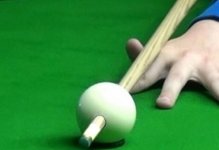Without reading through countless post. Are we aiming for the side of the pocket nearest the OB?
Cutting to the right, you aim for the left side of the pocket, cutting to the left, you aim for the right side of the pocket.
Here's the summary: You stay very close to center axis on the cb, favoring inside english side. You use a stop, or stun shot. Doing that, you get CIT that throws the ob towards the outside of the pocket. A touch of inside causes squirt which changes the angle of attack on the ob and makes you actually hit it thinner, putting it in the part of the pocket you aimed at.
Slight variations in speed or contact place on the cb will change the squirt and CIT slightly, but still keeping you going into the pocket. These changes largely occur when you need a little draw or follow off the tangent line, so you aren't hitting with an actual stun shot, but at the same speed as a stun shot would be.
In CJ's video of Mizerak and himself, he used a touch of inside 12 times, obvious outside favoring 10 times, more than a touch of inside 3 times, and center ball due to being fairly straight on the shot 11 times in the first 5 racks that he shot balls in. (I think the score was 5-1 CJ)
This is the same thing Dr. Dave, PJ, myself, and others have been saying on here for years. Apparently many only listen when a known pro says it. At least some of you are finally "getting it".
First look what a stop or stun shot does. Many times you only need a little follow or draw from the tangent line to obtain position. If you need some additional english, rarely will you need more than a tip (30% Dr. Dave) of english. When hit with a stun shot, you will get some CIT. That is easily countered with a touch of inside which provides a little squirt. Pick a part of the pocket to shoot at, be specific, not general. Pick an exact spot on the cb to hit, again, be specific, not general. Pay attention to what you are doing. Be as a surgeon, not a scythe user.
What CJ doesn't quite realize yet, is that he plays so great because of his ability to use the subconscious so much better than most are able to. That makes the game so much easier. He has found what works for him, which is also what the "science" has found out. He just is having trouble with the correct terminologies used today and sometimes says things the wrong way.
Since he says his game is just about back to where it was, I believe that if he were to take a look at what others have out there for reference lines, and how to precisely play position, he would be would have a good shot at being the best of all time.
Last edited:
